Screening and Characterization of Antioxidant Film Applicable to Walnut Kernels from Juglans sigillata
Abstract
:1. Introduction
2. Materials and Methods
2.1. Materials
2.2. Preparation of Film Fluid and Application to Walnut Kernels
2.2.1. Peroxide Value (PV)
2.2.2. Acid Value (AV)
2.2.3. Carbonyl Value (CV)
2.2.4. Malonic Dialdehyde (MDA)
2.2.5. Conjugated Diene Value (K232) and Conjugated Triene Value (K268)
2.2.6. Browning Degree
2.2.7. Moisture Content (MC)
2.3. Preparation of Film
2.3.1. Mechanical Properties and Thickness
2.3.2. Moisture Content and Water Solubility of Film
2.3.3. Water Vapor Permeability (WVP) and Oxygen Permeability (OP)
2.3.4. Appearance and Color
2.3.5. Opacity
2.3.6. Scanning Electron Microscope (SEM)
2.3.7. Fourier-Transform Infrared (FTIR) Spectroscopy
2.3.8. Differential Scanning Calorimetry (DSC)
2.3.9. Antimicrobial Activity
2.3.10. Antioxidant Activity
2.3.11. Stability of Sesamol in C/S-ses
2.3.12. Slow Release of Sesamol in C/S-ses
2.4. Statistical Analysis
3. Results and Discussion
3.1. Accelerated Oxidative Experiment of Walnut Kernels
3.1.1. PV
3.1.2. AV
3.1.3. CV
3.1.4. MDA
3.1.5. K232 and K268
3.1.6. Browning Degree
3.1.7. MC
3.2. Physicochemical Characterization of C, C/S, and C/S-ses Films
3.2.1. Mechanical Properties and Thickness
3.2.2. Moisture Content and Water Solubility
3.2.3. WVP and OP
3.2.4. Appearance and Color
3.2.5. Opacity
3.2.6. SEM
3.2.7. FTIR Spectroscopy
3.2.8. DSC
3.2.9. Antibacterial Activity
3.2.10. Antioxidant Activity
3.2.11. Stability of Sesamol in C/S-ses
3.2.12. Slow Release of Sesamol in C/S-ses
4. Conclusions
Supplementary Materials
Author Contributions
Funding
Institutional Review Board Statement
Informed Consent Statement
Data Availability Statement
Conflicts of Interest
References
- Cannella, C.; Dernini, S. Walnut: Insights and nutritional value. Acta Horti. 2006, 705, 547–550. [Google Scholar] [CrossRef]
- Pribis, P.; Bailey, R.N.; Russell, A.A.; Kilsby, M.A.; Hernandez, M.; Craig, W.J.; Grajales, T.; Shavlik, D.J.; Sabatè, J. Effects of walnut consumption on cognitive performance in young adults. Briti. J. Nutr. 2012, 107, 1393–1401. [Google Scholar] [CrossRef] [PubMed]
- Li, L.; Tsao, R.; Yang, R.; Kramer, J.K.G.; Hernandez, M. Fatty acid profiles, tocopherol contents, and antioxidant activities of heartnut (Juglans ailanthifolia Var. cordiformis) and persian walnut (Juglans regia L.). J. Agric. Food Chem. 2007, 55, 1164–1169. [Google Scholar] [CrossRef]
- Poulose, S.M.; Miller, M.G.; Shukitt-Hale, B. Role of walnuts in maintaining brain health with age. J. Nutr. 2014, 144, 561S–566S. [Google Scholar] [CrossRef]
- Grosso, A.L.; Riveros, C.; Asensio, C.M.; Grosso, N.R.; Nepote, V. Improving walnuts’ preservation by using walnut phenolic extracts as natural antioxidants through a walnut protein-based edible coating. J. Food Sci. 2020, 85, 3043–3051. [Google Scholar] [CrossRef]
- Pereira, J.A.; Oliveira, I.; Sousa, A.; Ferreira, I.C.F.R.; Bento, A.; Estevinho, L. Bioactive properties and chemical composition of six walnut (Juglans regia L.) cultivars. Food Chem. Toxicol. 2008, 46, 2103–2111. [Google Scholar] [CrossRef] [PubMed]
- Hayes, D.; Angove, M.J.; Tucci, J.; Dennis, C. Walnuts (Juglans regia) chemical composition and research in human health. Crit. Rev. Food Sci. Nutr. 2015, 56, 1231–1241. [Google Scholar] [CrossRef]
- Kwak, J.S.; Park, M.Y.; Kwon, O. The effect of walnut (Juglans regia L.) intake on improvement of blood lipid levels and vascular health: A meta-analysis. J. Nutr. Health 2014, 47, 236–246. [Google Scholar] [CrossRef]
- Christopoulos, M.V.; Tsantili, E. Storage of fresh walnuts (Juglans regia L.)—Low temperature and phenolic compounds. Postharvest Biol. Technol. 2012, 73, 80–88. [Google Scholar] [CrossRef]
- Gama, T.; Wallace, H.M.; Trueman, S.J.; Hosseini-Bai, S. Quality and shelf life of tree nuts: A review. Sci. Hortic. 2018, 242, 116–126. [Google Scholar] [CrossRef]
- Fu, M.R.; Qu, Q.L.; Yang, X.Y.; Zhang, X.H. Effect of intermittent oven drying on lipid oxidation, fatty acids composition and antioxidant activities of walnut. LWT Food Sci. Technol. 2016, 65, 1126–1132. [Google Scholar] [CrossRef]
- Sridhar, A.; Ponnuchamy, M.; Kumar, P.S.; Kapoor, A. Food preservation techniques and nanotechnology for increased shelf life of fruits, vegetables, beverages and spices: A review. Environ. Chem. Lett. 2021, 19, 1715–1735. [Google Scholar] [CrossRef] [PubMed]
- Amin, U.; Khan, M.U.; Majeed, Y.; Rebezov, M.; Khayrullin, M.; Bobkova, E.; Shariati, M.A.; Chung, I.M.; Thiruvengadam, M. Potentials of polysaccharides, lipids and proteins in biodegradable food packaging applications. Int. J. Biol. Macromol. 2021, 183, 2184–2198. [Google Scholar] [CrossRef]
- Balti, R.; Mansour, M.B.; Sayari, N.; Yacoubi, L.; Rabaoui, L.; Brodu, N.; Massé, A. Development and characterization of bioactive edible films from spider crab (Maja crispata) chitosan incorporated with Spirulina extract. Int. J. Biol. Macromol. 2017, 105, 1464–1472. [Google Scholar] [CrossRef]
- Al-Tayyar, N.A.; Youssef, A.M.; Al-hindi, R. Antimicrobial food packaging based on sustainable bio-based materials for reducing foodborne pathogens: A review. Food Chem. 2020, 310, 125915. [Google Scholar] [CrossRef] [PubMed]
- Benbettaïeb, N.; Karbowiak, T.; Debeaufort, F. Bioactive edible films for food applications: Influence of the bioactive compounds on film structure and properties. Crit. Rev. Food Sci. Nutr. 2019, 59, 1137–1153. [Google Scholar] [CrossRef] [PubMed]
- Kalaycıoğlu, Z.; Torlak, E.; Akın-Evingür, G.; Özen, İ.; Erim, F.B. Antimicrobial and physical properties of chitosan films incorporated with turmeric extract. Int. J. Biol. Macromol. 2017, 101, 882–888. [Google Scholar] [CrossRef] [PubMed]
- Mohammadian, E.; Alizadeh-Sani, M.; Jafari, S.M. Smart monitoring of gas/temperature changes within food packaging based on natural colorants. Compr. Rev. Food Sci. Food Saf. 2020, 19, 2885–2931. [Google Scholar] [CrossRef] [PubMed]
- Vimaladevi, S.; Panda, S.K.; Xavier, K.A.M.; Bindu, J. Packaging performance of organic acid incorporated chitosan films on dried anchovy (Stolephorus indicus). Carbohydr. Polym. 2015, 127, 189–194. [Google Scholar] [CrossRef]
- Wang, Z.Y.; Huang, J.B.; Yun, D.W.; Yong, H.M.; Liu, J. Antioxidant packaging films developed based on chitosan grafted with different catechins: Characterization and application in retarding corn oil oxidation. Food Hydrocoll. 2022, 133, 107970. [Google Scholar] [CrossRef]
- Chen, J.R.; Yang, S.C.; Suetsuna, K.; Chao, J.C.J. Soybean protein-derived hydrolysate affects blood pressure in spontaneously hypertensive rats. J. Food Biochem. 2004, 28, 61–73. [Google Scholar] [CrossRef]
- Wu, W.; Hettiarachchy, N.S.; Qi, M. Hydrophobicity, solubility, and emulsifying properties of soy protein peptides prepared by papain modification and ultrafiltration. J. Am. Oil Chem. Soc. 1998, 75, 845–850. [Google Scholar] [CrossRef]
- Ji, S.P.; Sun, R.; Wang, W.J.; Xia, Q. Preparation, characterization, and evaluation of tamarind seed polysaccharide-carboxymethylcellulose buccal films loaded with soybean peptides-chitosan nanoparticles. Food Hydrocoll. 2023, 141, 108684. [Google Scholar] [CrossRef]
- Salgado, P.R.; Fernández, G.B.; Drago, S.R.; Mauri, A.N. Addition of bovine plasma hydrolysates improves the antioxidant properties of soybean and sunflower protein-based films. Food Hydrocoll. 2011, 25, 1433–1440. [Google Scholar] [CrossRef]
- Bizymis, A.P.; Kalantzi, S.; Mamma, D.; Tzia, C. Addition of silver nanoparticles to composite edible films and coatings to enhance their antimicrobial activity and application to cherry preservation. Foods 2023, 12, 4295. [Google Scholar] [CrossRef] [PubMed]
- Farhoosh, R. New insights into the kinetic and thermodynamic evaluations of lipid peroxidation. Food Chem. 2022, 375, 131659. [Google Scholar] [CrossRef] [PubMed]
- Flórez, M.; Guerra-Rodríguez, E.; Cazón, P.; Vázquez, M. Chitosan for food packaging: Recent advances in active and intelligent films. Food Hydrocoll. 2022, 124, 107328. [Google Scholar] [CrossRef]
- Huang, G.H.; Huang, L.S.; Geng, C.; Lan, T.; Huang, X.S.; Xu, S.L.; Shen, Y.J.; Bian, H.D. Green and multifunctional chitosan-based conformal coating as a controlled release platform for fruit preservation. Int. J. Biol. Macromol. 2022, 219, 767–778. [Google Scholar] [CrossRef]
- Qin, Y.Y.; Yang, J.Y.; Lu, H.B.; Wang, S.S.; Yang, J.; Yang, X.C.; Chai, M.; Li, L.; Cao, J.X. Effect of chitosan film incorporated with tea polyphenol on quality and shelf life of pork meat patties. Int. J. Biol. Macromol. 2013, 61, 312–316. [Google Scholar] [CrossRef]
- Guitard, R.; Paul, J.F.; Nardello-Rata, V.; Aubry, J.M. Myricetin, rosmarinic and carnosic acids as superior natural antioxidant alternatives to α-tocopherol for the preservation of omega-3 oils. Food Chem. 2016, 213, 284–295. [Google Scholar] [CrossRef]
- Fhaner, M.; Hwang, H.S.; Winkler-Moser, J.K.; Bakota, E.L.; Liu, S.X. Protection of fish oil from oxidation with sesamol. Eur. J. Lipid Sci. Technol. 2016, 118, 885–897. [Google Scholar] [CrossRef]
- GB 5009.227-2016; Determination of Peroxide Value in National Food Safety Standard. Chinese Standard Publication House: Beijing, China, 2016.
- GB 5009.229-2016; Determination of Acid Value in National Food Safety Standard. Chinese Standard Publication House: Beijing, China, 2016.
- GB 5009.230-2016; Determination of Carbonyl Value in National Food Safety Standard. Chinese Standard Publication House: Beijing, China, 2016.
- Sharma, S.; Sharma, R.R. Impact of staggered treatments of novel molecules and ethylene absorbents on postharvest fruit physiology and enzyme activity of ‘Santa Rosa’ plums. Sci. Hortic. 2016, 198, 242–248. [Google Scholar] [CrossRef]
- GB/T 22500-2008/ISO3656:2002; Animal and Vegetable Fats and Oils—Determination of Ultraviolet Absorbance Expressed as Specific UV Extinction. Chinese Standard Publication House: Beijing, China, 2002.
- Jiang, Y.M. Role of anthocyanins, polyphenol oxidase and phenols in lychee pericarp browning. J. Sci. Food Agric. 2000, 80, 305–310. [Google Scholar] [CrossRef]
- GB 5009.3-2016; Determination of Moisture Content in National Food Safety Standard. Chinese Standard Publication House: Beijing, China, 2016.
- Jiang, L.W.; Luo, Z.; Liu, H.B.; Wang, F.H.; Li, H.Y.; Gao, H.C.; Zhang, H.J. Preparation and characterization of chitosan films containing lychee (Litchi chinensis sonn.) pericarp powder and their application as active food packaging. Foods 2021, 10, 2834. [Google Scholar] [CrossRef] [PubMed]
- Zhang, C.; Wang, Z.G.; Li, Y.; Yang, Y.J.; Ju, X.R.; He, R. The preparation and physiochemical characterization of rapeseed protein hydrolysate-chitosan composite films. Food Chem. 2019, 272, 694–701. [Google Scholar] [CrossRef] [PubMed]
- Park, S.; Zhao, Y.Y. Incorporation of a high concentration of mineral or vitamin into chitosan-based films. J. Agric. Food Chem. 2004, 52, 1933–1939. [Google Scholar] [CrossRef] [PubMed]
- Ardjoum, N.; Shankar, S.; Chibani, N.; Salmieri, S.; Lacroix, M. In situ synthesis of silver nanoparticles in pectin matrix using gamma irradiation for the preparation of antibacterial pectin/silver nanoparticles composite films. Food Hydrocoll. 2021, 121, 107000. [Google Scholar] [CrossRef]
- Lin, D.R.; Zheng, Y.; Wang, X.; Huang, Y.C.; Ni, L.; Chen, X.; Wu, Z.J.; Huang, C.Y.; Yi, Q.J.; Li, J.W.; et al. Study on physicochemical properties, antioxidant and antimicrobial activity of okara soluble dietary fiber/sodium carboxymethyl cellulose/thyme essential oil active edible composite films incorporated with pectin. Int. J. Biol. Macromol. 2020, 165, 1241–1249. [Google Scholar] [CrossRef] [PubMed]
- Huang, G.H.; Yan, Y.P.; Xu, D.X.; Wu, J.; Xu, C.H.; Fu, L.H.; Lin, B.F. Curcumin-loaded nanoMOFs@CMFP: A biological preserving paste with antibacterial properties and long-acting, controllable release. Food Chem. 2021, 337, 127987. [Google Scholar] [CrossRef]
- Ni, Y.S.; Nie, H.Q.; Wang, J.Y.; Lin, J.W.; Wang, Q.L.; Sun, J.; Zhang, W.T.; Wang, J.L. Enhanced functional properties of chitosan films incorporated with curcumin-loaded hollow graphitic carbon nitride nanoparticles for bananas preservation. Food Chem. 2022, 366, 130539. [Google Scholar] [CrossRef]
- Wang, Y.; Ni, X.W.; Wen, M.T.; Lou, S.R.; Xiao, W.L.; Gao, Z.M. Preparation of antioxidant konjac glucomannan-based films enriched with Ocimum gratissimum L. essential oil Pickering emulsion and its effect on walnuts preservation. Colloids Surf. A Physicochem. Eng. Aspects 2023, 665, 131220. [Google Scholar] [CrossRef]
- Rodrigues, J.S.; do Valle, C.P.; Uchoa, A.F.J.; Ramos, D.M.; da Ponte, F.A.F.; de Sousa Rios, M.A.; de Queiroz Malveira, J.; Ricardo, N.M.P.S. Comparative study of synthetic and natural antioxidants on the oxidative stability of biodiesel from Tilapia oil. Renew. Energy 2020, 156, 1100–1106. [Google Scholar] [CrossRef]
- Sun, Y.N.; Zhang, M.; Fan, D.C. Effect of ultrasonic on deterioration of oil in microwave vacuum frying and prediction of frying oil quality based on low field nuclear magnetic resonance (LF-NMR). Ultrason. Sonochem. 2019, 51, 77–89. [Google Scholar] [CrossRef] [PubMed]
- Lu, Y.L.; Lu, M.; Wang, J.Q.; Jiang, X.Y.; Lu, Y.; Qiu, C.Y.; Lv, L.S.; Dong, W.J. Inhibitory activity on the formation of reactive carbonyl species in edible oil by synthetic polyphenol antioxidants. J. Agric. Food Chem. 2021, 69, 9025–9033. [Google Scholar] [CrossRef] [PubMed]
- Huang, J.; Wu, W.J.; Niu, B.; Fang, X.J.; Chen, H.J.; Wang, Y.H.; Gao, H.Y. Characterization of Zizania latifolia polysaccharide-corn starch composite films and their application in the postharvest preservation of strawberries. LWT Food Sci. Technol. 2023, 173, 114332. [Google Scholar] [CrossRef]
- Yang, J.H.; Tran, T.T.T.; Le, V.V.M. Effects of natural antioxidants on the palm olein quality during the heating and frying. Food Meas. 2020, 14, 2713–2720. [Google Scholar] [CrossRef]
- Jiang, L.W.; Wang, F.H.; Xie, X.Y.; Xie, C.C.; Li, A.Q.; Xia, N.; Gong, X.; Zhang, H.J. Development and characterization of chitosan/guar gum active packaging containing walnut green husk extract and its application on fresh-cut apple preservation. Int. J. Biol. Macromol. 2022, 209, 1307–1318. [Google Scholar] [CrossRef]
- García-Pascual, P.; Mateos, M.; Carbonell, V.; Salazar, D.M. Influence of storage conditions on the quality of shelled and roasted almonds. Biosyst. Eng. 2003, 84, 201–209. [Google Scholar] [CrossRef]
- Kiralan, M.; Kayahan, M.; Kiralan, S.S.; Ramadan, M.F. Effect of thermal and photo oxidation on the stability of cold-pressed plum and apricot kernel oils. Eur. Food. Res. Technol. 2018, 244, 31–42. [Google Scholar] [CrossRef]
- Gacche, R.N.; Warangkar, S.C.; Ghole, V.S. Glutathione and cinnamic acid: Natural dietary components used in preventing the process of browning by inhibition of polyphenol oxidase in apple juice. J. Enzyme Inhib. Med. Chem. 2004, 19, 175–179. [Google Scholar] [CrossRef]
- Mahendra Kumar, C.; Singh, S.A. Bioactive lignans from sesame (Sesamum indicum L.): Evaluation of their antioxidant and antibacterial effects for food applications. J. Food Sci. Technol. 2015, 52, 2934–2941. [Google Scholar] [CrossRef] [PubMed]
- Casariego, A.; Souza, B.W.S.; Cerqueira, M.A.; Teixeira, J.A.; Cruz, L.; Díaz, R.; Vicente, A.A. Chitosan/clay films’ properties as affected by biopolymer and clay micro/nanoparticles’ concentrations. Food Hydrocoll. 2009, 23, 1895–1902. [Google Scholar] [CrossRef]
- Meerasri, J.; Sothornvit, R. Characterization of bioactive film from pectin incorporated with gamma-aminobutyric acid. Int. J. Biol. Macromol. 2020, 147, 1285–1293. [Google Scholar] [CrossRef] [PubMed]
- Roy, S.; Rhim, J.W. Preparation of carbohydrate-based functional composite films incorporated with curcumin. Food Hydrocoll. 2019, 98, 105302. [Google Scholar] [CrossRef]
- Feng, S.S.; Liu, L.P.; Li, H.Y.; Guo, Y.X.; Huo, Y.X.; Wu, X.J.; Zhang, L.L.; Xu, J.G. Characterization, antioxidant and antibacterial activities of chitosan/flaxseed soluble dietary fiber/sesamol blend films and their application in pork preservation. Food Hydrocoll. 2024, 147, 109370. [Google Scholar] [CrossRef]
- Guan, X.; Li, L.; Li, S.; Liu, J.; Huang, K. A food-grade continuous electrospun fiber of hordein/chitosan with water resistance. Food Biosci. 2020, 37, 100687. [Google Scholar] [CrossRef]
- Lei, Y.L.; Wu, H.J.; Jiao, C.; Jiang, Y.; Liu, R.; Xiao, D.; Lu, J.Y.; Zhang, Z.Q.; Shen, G.H.; Li, S.S. Investigation of the structural and physical properties, antioxidant and antimicrobial activity of pectin-konjac glucomannan composite edible films incorporated with tea polyphenol. Food Hydrocoll. 2019, 94, 128–135. [Google Scholar] [CrossRef]
- Zhang, L.M.; Liu, Z.L.; Wang, X.Y.; Dong, S.; Sun, Y.; Zhao, Z.T. The properties of chitosan/zein blend film and effect of film on quality of mushroom (Agaricus bisporus). Postharvest Biol. Technol. 2019, 155, 47–56. [Google Scholar] [CrossRef]
- Rubilar, J.F.; Cruz, R.M.S.; Silva, H.D.; Vicente, A.A.; Khmelinskii, I.; Vieira, M.C. Physico-mechanical properties of chitosan films with carvacrol and grape seed extract. J. Food Eng. 2013, 115, 466–474. [Google Scholar] [CrossRef]
- Wang, K.L.; Li, X.R.; Peng, H.Z.; Dong, Y.M.; Li, Y.J.; Liu, X.R.; Li, J.Z. Tough and strong soy protein film by integrating CNFs and MXene with photothermal conversion and UV-blocking performance. Cellulose 2022, 29, 9235–9249. [Google Scholar] [CrossRef]
- de Oliveira Filho, J.G.; Rodrigues, J.M.; Valadares, A.C.F.; de Almeida, A.B.; de Lima, T.M.; Takeuchi, K.P.; Alves, C.C.F.; de Figueiredo Sousa, A.; da Silva, E.R.; Dyszy, F.H.; et al. Active food packaging: Alginate films with cottonseed protein hydrolysates. Food Hydrocoll. 2019, 92, 267–275. [Google Scholar] [CrossRef]
- Homez-Jara, A.; Daza, L.D.; Aguirre, D.M.; Muñoz, J.A.; Solanilla, J.F.; Váquiro, H.A. Characterization of chitosan edible films obtained with various polymer concentrations and drying temperatures. Int. J. Biol. Macromol. 2018, 113, 1233–1240. [Google Scholar] [CrossRef] [PubMed]
- Xie, H.X.; Ouyang, K.F.; Zhang, L.Q.; Hu, J.W.; Huang, S.F.; Sun, W.W.; Xiong, H.; Zhao, Q. Chitosan/rice hydrolysate/curcumin composite film: Effect of chitosan molecular weight. Int. J. Biol. Macromol. 2022, 210, 53–62. [Google Scholar] [CrossRef] [PubMed]
- Ren, G.R.; He, Y.; Liu, C.Z.; Ni, F.F.; Luo, X.; Shi, J.Y.; Song, Y.; Li, T.; Huang, M.; Shen, Q.; et al. Encapsulation of curcumin in ZEIN-HTCC complexes: Physicochemical characterization, in vitro sustained release behavior and encapsulation mechanism. LWT Food Sci. Technol. 2022, 155, 112909. [Google Scholar] [CrossRef]
- Kchaou, H.; Jridi, M.; Benbettaieb, N.; Debeaufort, F.; Nasri, M. Bioactive films based on cuttlefish (Sepia officinalis) skin gelatin incorporated with cuttlefish protein hydrolysates: Physicochemical characterization and antioxidant properties. Food Packag. Shelf Life 2020, 24, 100477. [Google Scholar] [CrossRef]
- Wang, K.; Wu, K.; Xiao, M.; Kuang, Y.; Corke, H.; Ni, X.W.; Jiang, F.T. Structural characterization and properties of konjac glucomannan and zein blend films. Int. J. Biol. Macromol. 2017, 105, 1096–1104. [Google Scholar] [CrossRef] [PubMed]
- Roos, Y.; Karel, M. Plasticizing effect of water on thermal behavior and crystallization of amorphous food models. J. Food Sci. 1991, 56, 38–43. [Google Scholar] [CrossRef]
- Sun, L.J.; Sun, J.J.; Chen, L.; Niu, P.F.; Yang, X.B.; Guo, Y.R. Preparation and characterization of chitosan film incorporated with thinned young apple polyphenols as an active packaging material. Carbohydr. Polym. 2017, 163, 81–91. [Google Scholar] [CrossRef] [PubMed]
- Sallam, K.I.; Abd-Elghany, S.M.; Imre, K.; Morar, A.; Herman, V.; Hussein, M.A.; Mahros, M.A. Ensuring safety and improving keeping quality of meatballs by addition of sesame oil and sesamol as natural antimicrobial and antioxidant agents. Food Microbiol. 2021, 99, 103834. [Google Scholar] [CrossRef]
- Dai, L.; Sun, C.X.; Li, R.R.; Mao, L.K.; Liu, F.G.; Gao, Y.X. Structural characterization, formation mechanism and stability of curcumin in zein-lecithin composite nanoparticles fabricated by antisolvent co-precipitation. Food Chem. 2017, 237, 1163–1171. [Google Scholar] [CrossRef]
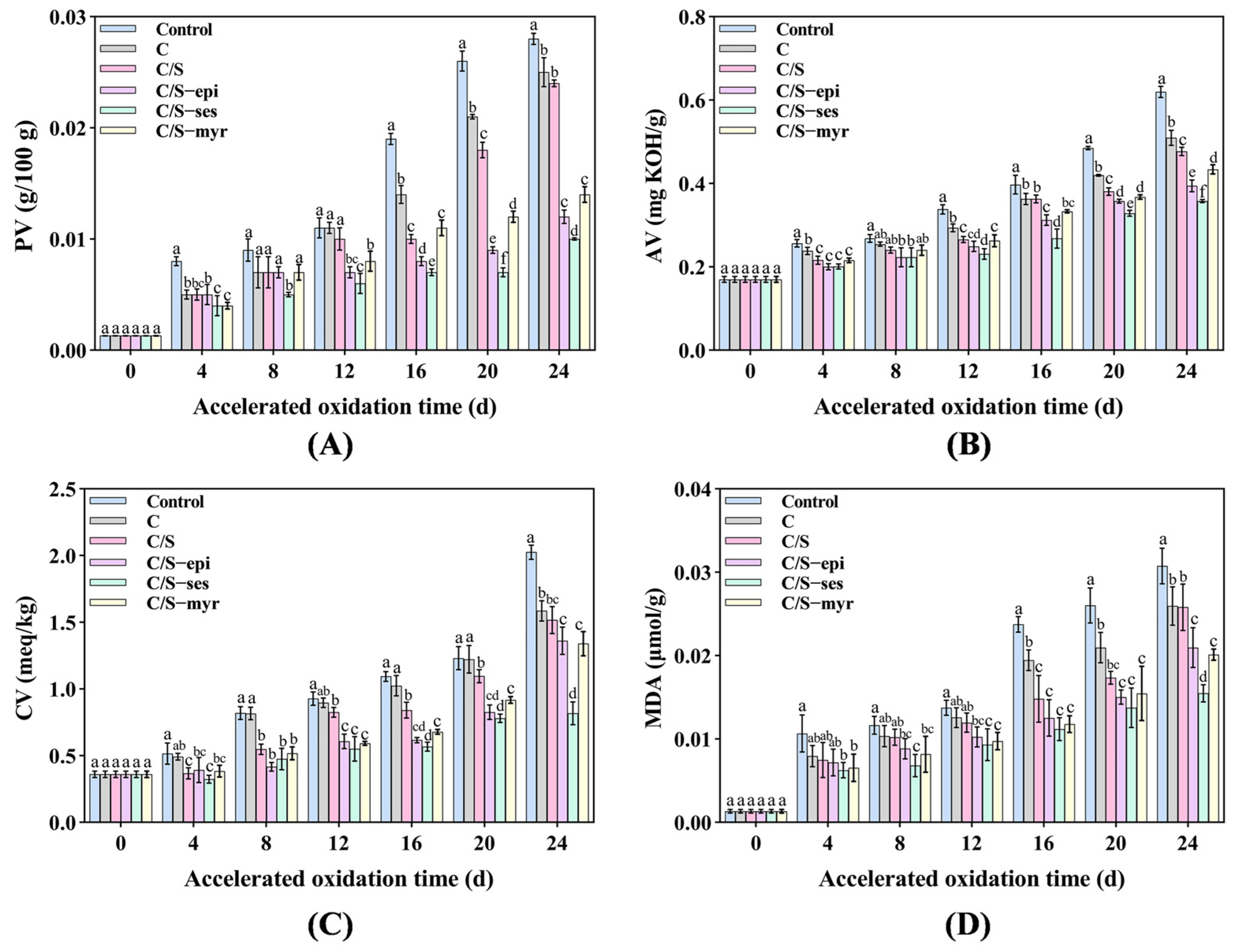
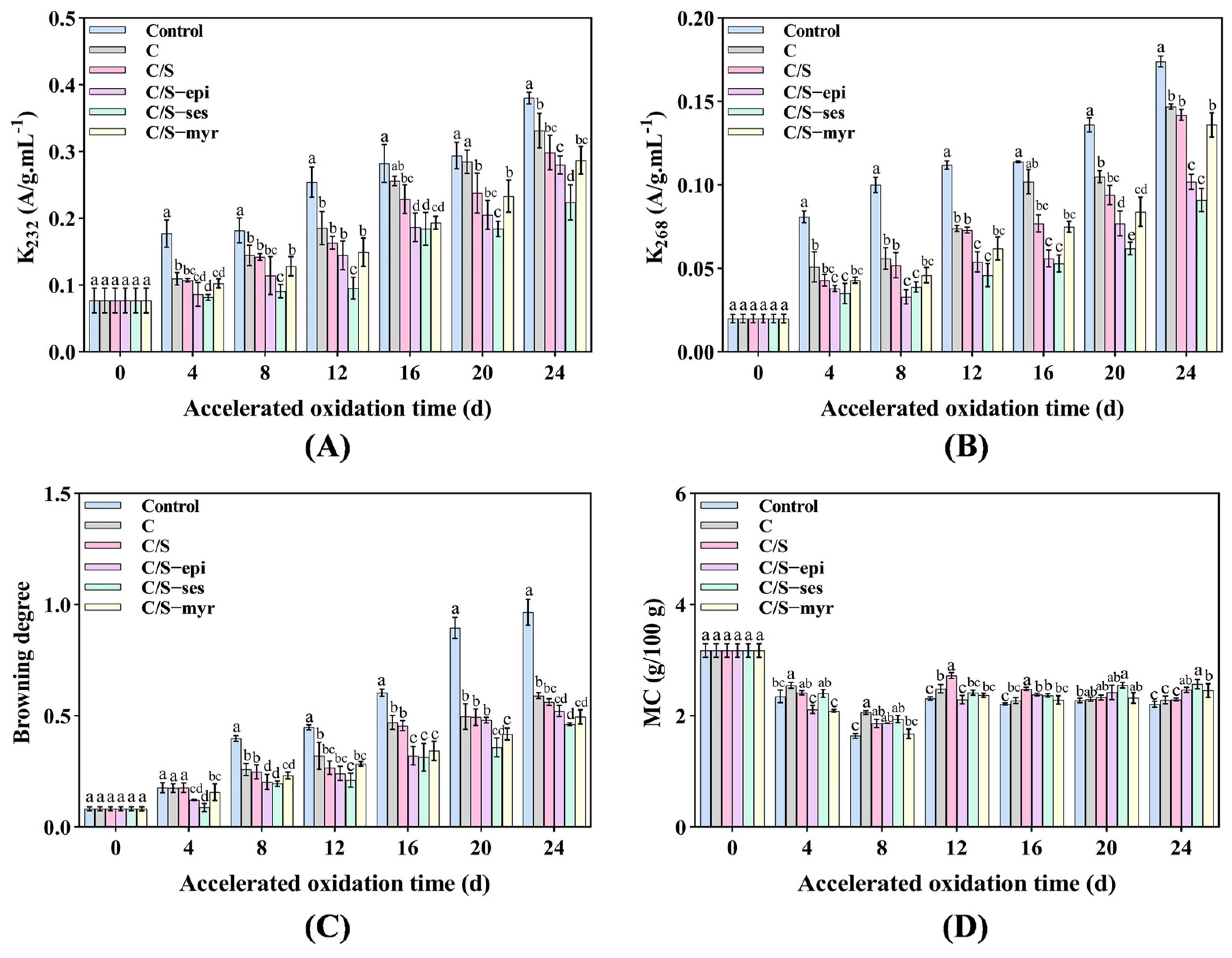
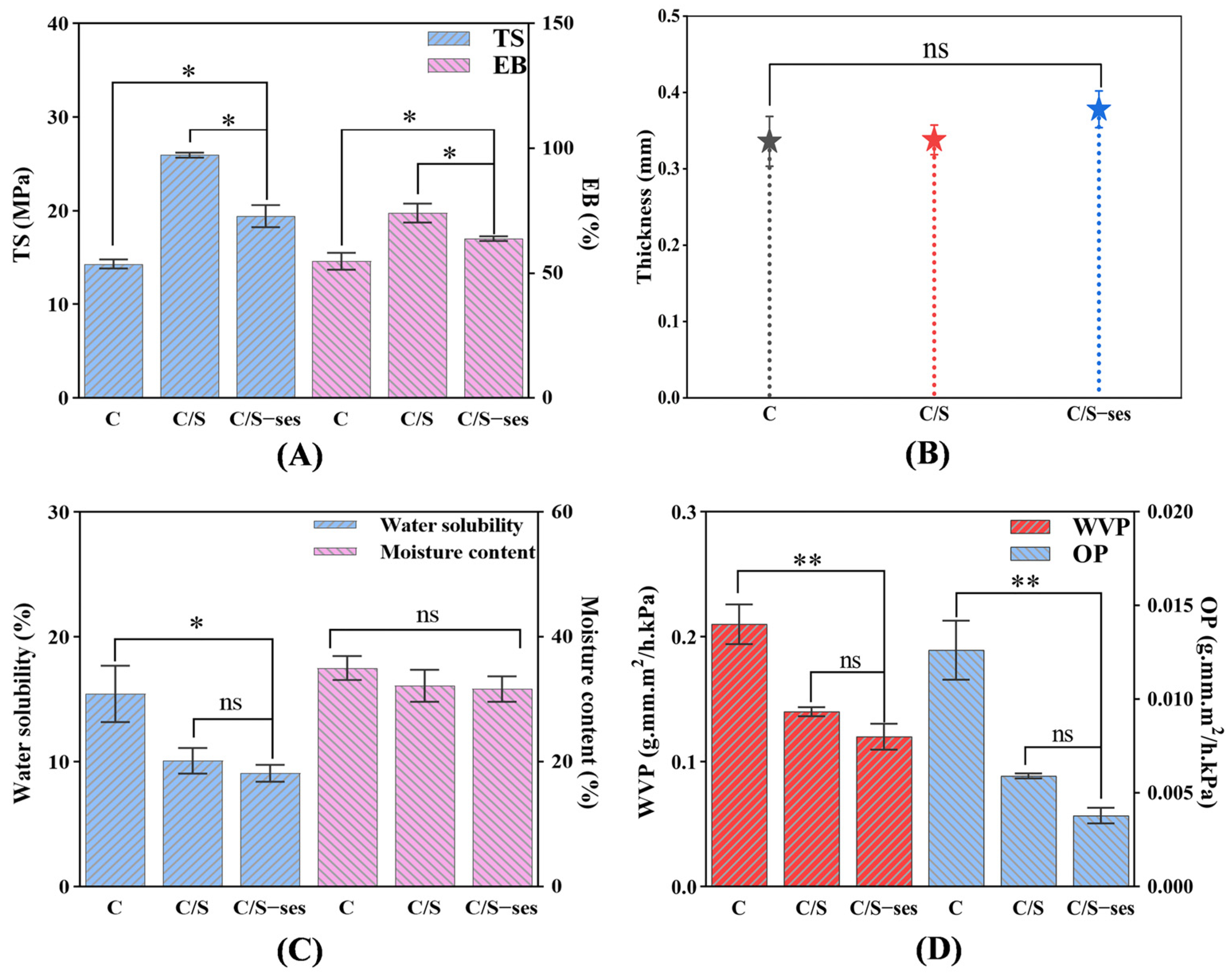

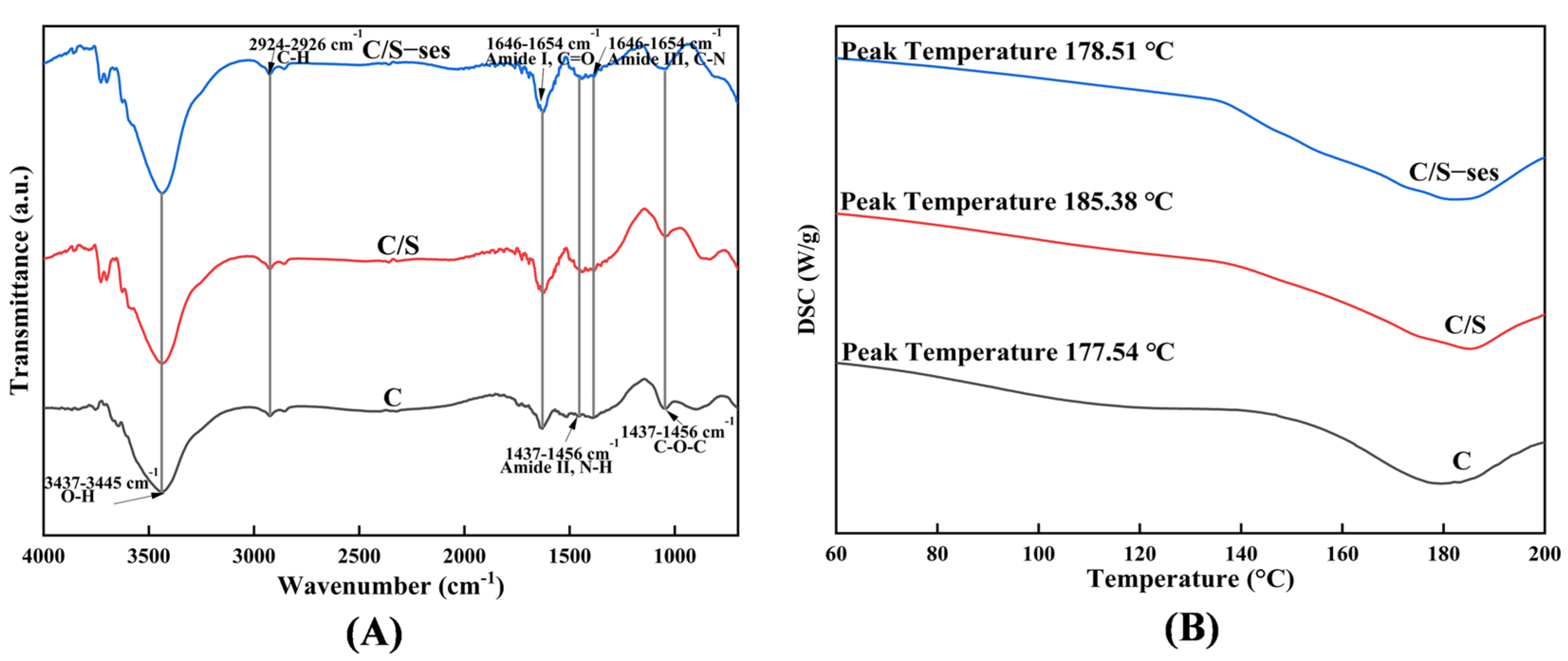

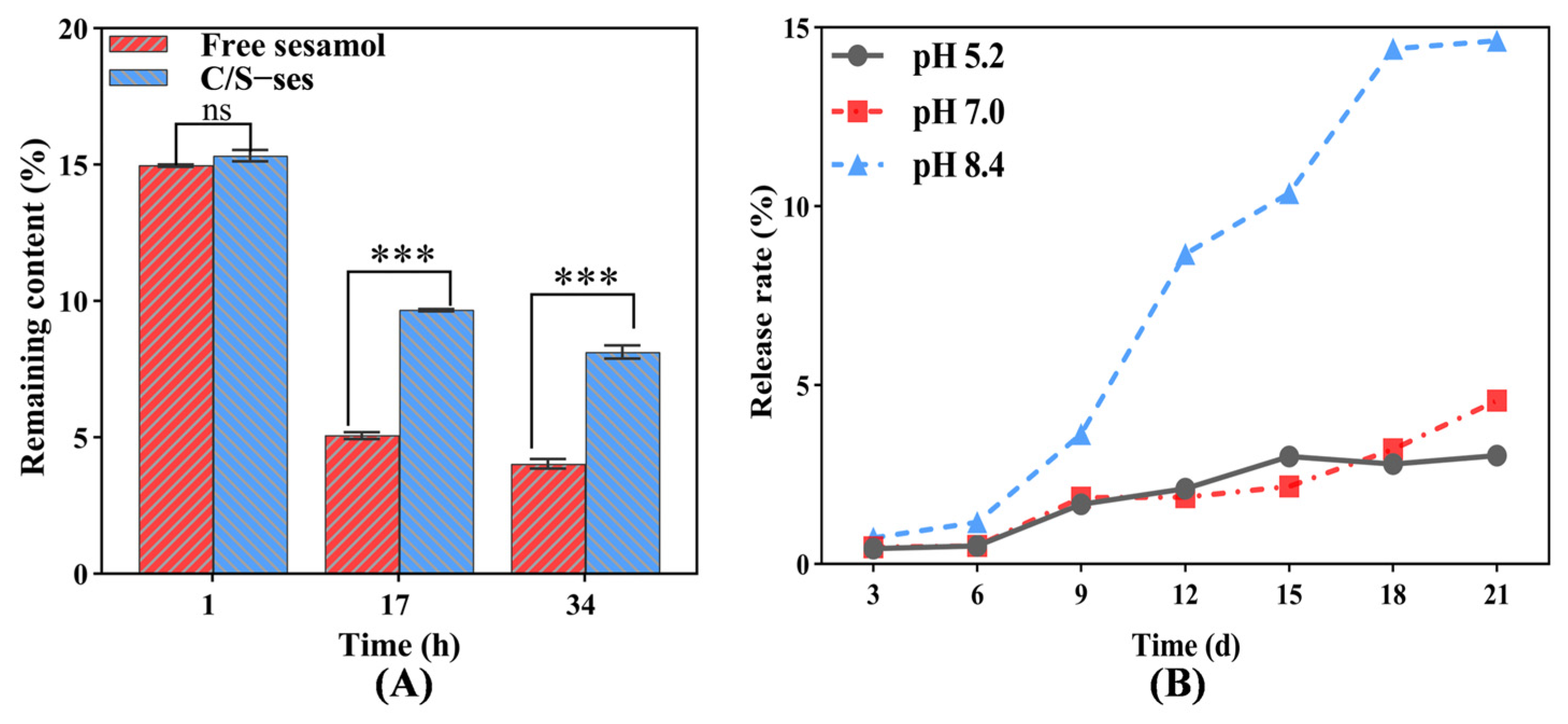
| Sample | Appearance | L* | a* | b* | ΔE | Opacity |
|---|---|---|---|---|---|---|
| C |  | 39.52 ±0.34 a | 3.49 ± 0.81 a | 5.37 ± 0.33 c | 61.02 ± 0.33 c | 0.27 ± 0.03 c |
| C/S |  | 36.04 ± 0.72 b | −4.70 ± 0.43 b | 7.388 ± 0.27 b | 64.19 ± 0.72 b | 0.34 ± 0.01 b |
| C/S-ses |  | 33.46 ± 0.67 c | −4.37 ± 0.67 b | 8.266 ± 0.41 a | 67.38 ±0.58 a | 0.39 ± 0.02 a |
Disclaimer/Publisher’s Note: The statements, opinions and data contained in all publications are solely those of the individual author(s) and contributor(s) and not of MDPI and/or the editor(s). MDPI and/or the editor(s) disclaim responsibility for any injury to people or property resulting from any ideas, methods, instructions or products referred to in the content. |
© 2024 by the authors. Licensee MDPI, Basel, Switzerland. This article is an open access article distributed under the terms and conditions of the Creative Commons Attribution (CC BY) license (https://creativecommons.org/licenses/by/4.0/).
Share and Cite
Li, P.; Zhang, Y.; Cao, C.; Luo, Y.; Kan, H.; Liu, Y. Screening and Characterization of Antioxidant Film Applicable to Walnut Kernels from Juglans sigillata. Foods 2024, 13, 1313. https://doi.org/10.3390/foods13091313
Li P, Zhang Y, Cao C, Luo Y, Kan H, Liu Y. Screening and Characterization of Antioxidant Film Applicable to Walnut Kernels from Juglans sigillata. Foods. 2024; 13(9):1313. https://doi.org/10.3390/foods13091313
Chicago/Turabian StyleLi, Ping, Yujia Zhang, Changwei Cao, Yaxi Luo, Huan Kan, and Yun Liu. 2024. "Screening and Characterization of Antioxidant Film Applicable to Walnut Kernels from Juglans sigillata" Foods 13, no. 9: 1313. https://doi.org/10.3390/foods13091313
APA StyleLi, P., Zhang, Y., Cao, C., Luo, Y., Kan, H., & Liu, Y. (2024). Screening and Characterization of Antioxidant Film Applicable to Walnut Kernels from Juglans sigillata. Foods, 13(9), 1313. https://doi.org/10.3390/foods13091313






